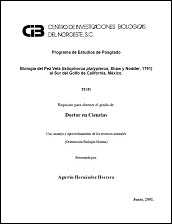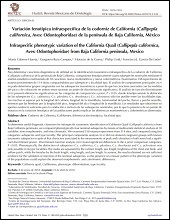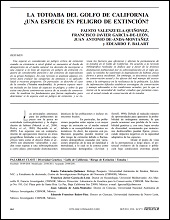VARIABILIDAD DE LA PRODUCTIVIDAD PRIMARIA Y DE PIGMENTOS FOTOSINTÉTICOS EN UNA ZONA DE SURGENCIAS DE LA REGIÓN SUR DE LA CORRIENTE DE CALIFORNIA
Variabilty of the primary productivity and photosythetic pigments in a swelling zone in the South region of the California Current
Autor
IBAN MURILLO MURILLO
RAFAEL CERVANTES DUARTE
GILBERTO GAXIOLA CASTRO
SILVERIO LOPEZ LOPEZ
FERNANDO AGUIRRE BAHENA
EDUARDO GONZALEZ RODRIGUEZ
ANGEL RAFAEL JIMENEZ ILLESCAS
FRANCISCO EDUARDO HERNANDEZ SANDOVAL
Metadatos
Mostrar el registro completo del ítemResumen
"Se analizaron procesos y condiciones físicas y químicas de la columna de agua frente a Bahía Magdalena, BCS durante un ciclo anual (2008-2009), con el objetivo de determinar su influencia sobre la variabilidad estacional en la productividad primaria (método de 14C) y de algunos grupos del fitoplancton que se caracterizaron por perfil de pigmentos fotosintéticos. Se analizó información de viento local, Índice de Surgencia Costera, CTD (temperatura y salinidad) y nutrientes inorgánicos disueltos (NO2¯+NO3¯, PO4¯3 y SiO3¯2). La distribución de la temperatura en la columna de agua mostró tres etapas hidrográficas durante el año de muestreo (estratificación, transición y mezcla). Los valores integrados de los pigmentos fotosintéticos variaron de forma similar a la temperatura, con las menores concentraciones durante la etapa de estratificación y las mayores en mezcla. Los nutrientes y la productividad primaria (PP) mostraron dos condiciones temporales muy bien definidas, con valores bajos de septiembre a febrero y altos de marzo a junio. Estas dos etapas se presentaron en condiciones de baja (<66 m3 s-1 100 m línea de costa) y alta (>125 m3 s-1 100 m línea de costa) intensidad del índice de surgencias costeras, respectivamente. Se concluye que las surgencias costeras son un fenómeno que modula los niveles de PP (r= 0.74, p<0.05) frente a Bahía Magdalena, afectando la disponibilidad de nutrientes en la zona eufótica. La presencia y concentración de los pigmentos fotosintéticos mostraron una variabilidad modulada por las tres etapas hidrográficas, con mínima concentración durante estratificación y transición, y máxima en la etapa de mezcla debido a la presencia de las surgencias costeras (mezcla vertical)." "Processes and physical-chemical conditions of the water column off Bahía Magdalena, BCS were analyzed during an annual cycle (2008-2009), to determine their influence on the seasonal variability of primary production (14C) and selected phytoplankton groups characterized by their photosynthetic pigments. Local wind data, coastal upwelling index, temperature and salinity (CTD) and inorganic dissolved nutrients (NO2¯+NO3¯, PO4¯3, and SiO3¯2) were also analyzed. The temperature distribution in the water column showed three hydrographic stages during the study (stratification, transition and mixing). Integrated values of the photosynthetic pigments varied in a similar way as temperature, with lower concentrations during the stratification stage and higher during the mixing stage. Nutrients and primary productivity (PP) showed two defined seasonal conditions, with low values from September to February, and high values from March to June. These two stages were observed respectively during low (<66 m3 s-1100 m shoreline) and high (>125 m3 s-1100 m shoreline) intensity according to the coastal upwelling index. We conclude that coastal upwelling is the process modulating the PP level (r= 0.74, p<0.05) off Bahía Magdalena, influencing nutrient availability in the euphotic zone. The presence and concentration of photosynthetic pigments showed a modulated variability in the three hydrographical stages, with minimal concentrations during the stratification and transition, and a maximum at the mixing stage due to the presence of coastal upwelling (vertical mixing)."
Colecciones
Ítems relacionados
Mostrando ítems relacionados por Título, autor o materia.
-
Variación fenotípica infraespecífica de la codorniz de California (Callipepla californica, Aves: Odontophoridae) de la península de Baja California, México
MARIA DEL ROCIO CABRERA HUERTA; GORGONIO RUIZ CAMPOS; Horacio Jesús de la Cueva Salcedo; Philip Unitt; FRANCISCO JAVIER GARCIA DE LEON -
DETERMINACIÓN DE BIOMASA Y BANCOS DE LA ALMEJA DE SIFÓN Panopea globosa (Dall, 1898) EN UNA ZONA VIRGEN DEL ALTO GOLFO DE CALIFORNIA
SERGIO ALEJANDRO PEREZ VALENCIA; EUGENIO ALBERTO ARAGON NORIEGA -
LA TOTOABA DEL GOLFO DE CALIFORNIA ¿UNA ESPECIE EN PELIGRO DE EXTINCIÓN?
FAUSTO VALENZUELA QUIÑONEZ; FRANCISCO JAVIER GARCIA DE LEON; JUAN ANTONIO DE ANDA MONTAÑEZ; EDUARDO FRANCISCO BALART PAEZ



